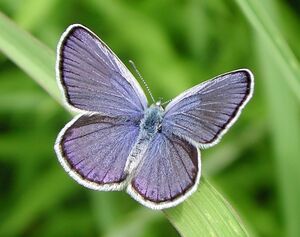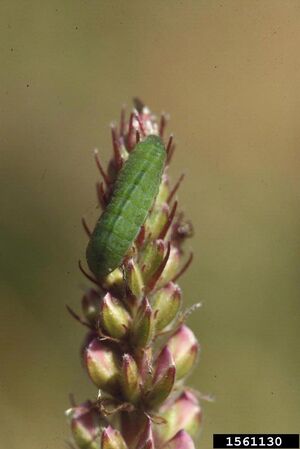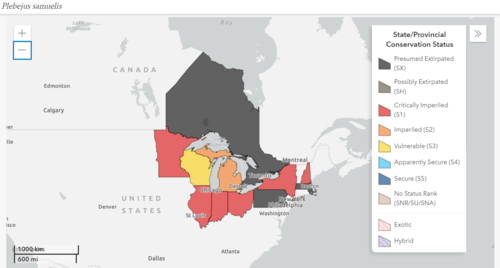Karner blue
(Plebejus samuelis) or the Karner Blue is an endangered species of blue butterfly found in some regions of New York and other Great Lakes states, areas of New Jersey, and southern areas in New Hampshire. The butterfly, whose life cycle depends on the wild blue lupine flower was classified as an endangered species in the United States in 1992.

| |
| Kingdom: | Animalia |
|---|---|
| Phylum: | Arthropoda |
| Class: | Insecta |
| Order: | Lepidoptera |
| Family: | Lycaenidae |
| Genus: | Plebejus |
| Species: | P. samuelis |
| Source: Nature Serve [1] | |
Description
The male and female show sexual dimorphism, which is the difference in appearance between female and male butterflies. The topside of the male is silvery or dark blue with narrow black margins. Females are grayish brown to blue in color on the topside portions of wings with irregular bands of orange crescents inside the narrow black border. Both males and females have a gray underside with a band of orange crescents along the edges of both wings and scattered black spots with white circles. They have an average wing span of 2.2- 3.5 cm. Karner Blue are considered endangered due to a dramatic range decline. They are considered (G1) critically imperiled according to Nature Serve Explorer
Range and Habitat
Range
Kerner blue butterflies natural ranges once was a narrow band across 12 states and parts of Ontario, Canada. [2] Today eastern subspecies populations are found in southern New Hampshire, central New York all the way to Wisconsin. Western subspecies populations occur in the intermountain west from Canada to Baja California plains and prairies, all the way to northwest Iowa and Southwestern Minnesota. [3]
Habitat
Historically, Karner blue butterflies occupied pine barren and oak and pine-oak savannah ecosystems with sandy pine prairies, barrens, and lakeshore dunes in the northeastern and Midwestern parts of the United States. Now, in eastern New York these butterflies live in remnants of barrens or savannahs, highway and power line corridors, gaps within forest ecosystems, young forests, trails and road systems of forests, airports, and military camps. These new habitats share the same structures consisting of open patchy canopy with grasses and forbs in the open space. [4]
Life Cycle

The Karner blue butterfly usually has two flight periods each year, the first flight are eggs that hatch in April. These eggs were laid butterflies last year and survived overwinter. The larvae that emerge pass through four in- stars. The caterpillars then feed only on wild lupine plant leaves, mainly on leaf mesophyll. [5] Karner blue butterflies have a mutualistic relationship with around 27 different ant species. larvae that are tended by ants develop rapidly and exhibited a steep rise in weight. [6] The ants protect the caterpillars from some natural predators or parasites and in return the ants recieve nectar from the caterpillar. The caterpillars and pupae have special glands that secrete juices high in sugars and amino acids that are harvested. In May, the caterpillars pupate, and the first brood adult butterflies emerge from their cocoon-like chrysalis by early June. The now adult butterflies’ mate and lay their eggs in June on wild lupine plants. The eggs hatch in about one week and the caterpillars feed for about three weeks. They then pupate and the summer's second generation of adult butterflies appears in July. These adults then mate and lay eggs that will not hatch until the following spring.
Diet
Karner blue caterpillar feed only on the leaves of the wild lupine plant. Lupine plants are perennial herbs with showy clusters of blue/purple pea-like flowers that are in clusters on stems. Adults feed on the nectar of multiple native and non-native flowering plant species. The Karner blue butterfly exhibits generalist but also selective characteristics of some nectar species. Across the Karner blue's range at least 51 first brood nectar species and 71 second brood nectar species have been noted. [7] Because the Karner blue caterpillar can only successfully feed on wild lupine, the reproductive success of the larvae is critically dependent on wild lupine plants.
Predation
The Karner Blue butterfly has a few predators in both larval and adult forms. Some larval predators are spiders, stink bugs, paper wasps and ants. These ant predators are different species from the ants that tend to the larvae. The seven-spotted lady beetle is one of the few confirmed predators of Karner blue butterfly larvae. [8] More potential larval predators include green lacewings, Soldier Beetles, and damsel bugs. Adult Karner blue butterfly predators are crab spiders, robber flies, ambush bugs, assassin bugs, and dragonflies. Other predators include white-tailed deer and birds from predation of butterfly eggs, larvae, and pupae by grazing on wild lupine. There are four larval parasites: the tachinid fly Aplomya theclarum, the braconid wasp Apanteles sp., and two ichneumonid wasps Neotypus nobilitator and Parania geniculate. [9]
Management
The Karner Blue is eradicated or endangered in several states and has The Nature Conservancy rank of T2 - Imperiled because of rarity (6 to 20 occurrences), or because of other factors demonstrably making it very vulnerable to extinction throughout its range. [10] Overall, the Karner blue has main requirements: lupine for larvae and nectar for adults. The goal of management is to provide this endangered species with a landscape that contains quality habitat patches situated to allow gene flow among patches and to allow recolonization following local extinction. Two conclusions important for Karner blue butterfly landscape management and monitoring are suggested by our data: (1) Efforts should be made to maintain subpopulations of Karner blues within 300 m of each other to allow dispersal among those subpopulations. (2) A 2:1 male:female sex ratio occurred at the population peak with- in a brood. A wide variety of management techniques are used like mowing which can maintain open areas with little to no detrimental effect on Karner blue butterflies. Controlled fires can also be used to maintain sites in early successional stages. Other management practices that are encouraged are: establishing dispersal corridors for adult butterflies, creating openings to promote lupine and nectaring sources, and propagating/planting lupine and nectaring sources as needed. There are some management practices that need to be avoided because they are typically harmful to Karner blue butterflies. Practices that increase deer and/or grouse populations, close-cropped grazing, frequent or poorly timed mowing, plowing, use of herbicides that kill lupine or nectar plants, and use of pesticides that are detrimental to Karner blue butterflies, ants they associate with, or pollinators of species they use for nectar. [11]
References
- ↑ “Plebejus Samuelis Karner Blue.” NatureServe Explorer 2.0, https://explorer.natureserve.org/Taxon/ELEMENT_GLOBAL.2.120997/Plebejus_samuelis.
- ↑ “Melissa Blue (Includes Karner Blue) Plebejus Melissa (W.H. Edwards, 1873).” Melissa Blue (Includes Karner Blue) Plebejus Melissa (W.H. Edwards, 1873) | Butterflies and Moths of North America, 28 Aug. 2022, https://www.butterfliesandmoths.org/species/Plebejus-melissa.
- ↑ “Karner Blue Butterfly (Lycaeides Melissa Samuelis): U.S. Fish & Wildlife Service.” FWS.gov, https://www.fws.gov/species/karner-blue-butterfly-lycaeides-melissa-samuelis.
- ↑ Forrester, Jodi A., et al. “Maintaining Critical Habitat in a Heavily Managed Landscape: Effects of Power Line Corridor Management on Karner Blue Butterfly (Lycaeides Melissa Samuelis) Habitat.” Restoration Ecology, vol. 13, no. 3, 2005, pp. 488–98, https://doi.org/10.1111/j.1526-100X.2005.00061.x.
- ↑ Knutson, Randy L., et al. “Movement Patterns and Population Characteristics of the Karner Blue Butterfly (Lycaeides Melissa Samuelis) at Indiana Dunes National Lakeshore.” Natural Areas Journal, vol. 19, no. 2, 1999, pp. 109–20.
- ↑ Grundel, R., et al. “Effect of Canopy Cover and Seasonal Change on Host Plant Quality for the Endangered Karner Blue Butterfly (Lycaeides Melissa Samuelis).” Oecologia, vol. 114, no. 2, 1998, pp. 243–50, https://doi.org/10.1007/s004420050442
- ↑ GRUNDEL, RALPH, et al. “Nectar Plant Selection by the Karner Blue Butterfly (Lycaeides Melissa Samuelis) at the Indiana Dunes National Lakeshore.” The American Midland Naturalist, vol. 144, no. 1, 2000, pp. 1–10, https://doi.org/10.1674/0003-0031(2000)144[0001:NPSBTK]2.0.CO;2.
- ↑ Schellhorn, Nancy A., et al. “The Co-Occurrence of an Introduced Biological Control Agent (Coleoptera: Coccinella Septempunctata) and an Endangered Butterfly (Lepidoptera: Lycaeides Melissa Samuelis).” Journal of Insect Conservation, vol. 9, no. 1, 2005, pp. 41–47, https://doi.org/10.1007/s10841-004-4887-2.
- ↑ Johnson, Kurt., and Steven L. Coates. Nabokov’s Blues : the Scientific Odyssey of a Literary Genius. 1st ed., Zoland Books, 1999.
- ↑ “Karner Blue Butterfly.” The Nature Conservancy, 9 Sept. 2018, https://www.nature.org/en-us/get-involved/how-to-help/animals-we-protect/karner-blue-butterfly/
- ↑ Karner Blue Butterfly (Lycaeides Melissa Samuelis) Recovery Plan. U.S. Fish and Wildlife Service, Region 3, 2003.
- ↑ Haack, Robert A. 1993. The endangered Karner blue butterfly (Lepidoptera: Lycaenidae): biology, management considerations, and data gaps. In: Gillespie, Andrew R.; Parker, George R.; Pope, Phillip E.; Rink, George: eds. Proceedings of the 9th Central Hardwood Forest Conference; Gen. Tech. Rep. NC-161. St. Paul, MN: U.S. Department of Agriculture, Forest Service, North Central Forest Experiment Station: 83-100
- ↑ Smallidge, Peter J., et al. “Community Characteristics and Vegetation Management of Karner Blue Butterfly (Lycaeides Melissa Samuelis) Habitats on Rights-of-Way in East- Central New York, USA.” The Journal of Applied Ecology, vol. 33, no. 6, 1996, pp. 1405–19, https://doi.org/10.2307/2404780
- ↑ Maxwell, Judith Ann. The Conservation of the Karner Blue Butterfly (Lycaeides Melissa Samuelis Nabokov): Ecological Studies on Habitat Creation and Management. ProQuest Dissertations Publishing, 1998.
